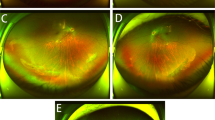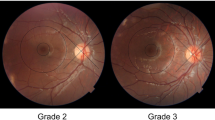Abstract
Purpose
To evaluate the fundus characteristics of highly myopic eyes in children.
Methods
We reviewed the medical records of 46 children (1 to 8 years old; mean age, 6.8 years) (80 eyes) with high myopia (4 D or more for children younger than 5 years, 6 D or more for children aged 6–8 years) seen consecutively during a 10-year period at the high-myopia clinic in our hospital. Children of up to 8 years of age at the initial visit were included in the study.
Results
Fundus examination revealed posterior staphyloma in only one eye (1.3%) and mild chorioretinal atrophy around the optic disc in 13 eyes (16.3%). There were no patients with choroidal neovascularization or geographic atrophy in the posterior fundus. Myopic peripapillary crescent was observed in 26 eyes (33.8%), but the area of the crescent was relatively small (mean, 0.5 disc area).
Conclusions
The results of the present study showed that myopic fundus changes are uncommon and mild in children. They suggest that aging, in addition to mechanical stretching of the eyeball, might be important for the development of myopic fundus changes. Jpn J Ophthalmol 2005;49:306–311© Japanese Ophthalmological Society 2005
Similar content being viewed by others
References
IM Ghafour D Allan WS Foulds (1983) ArticleTitleCommon causes of blindness and visual handicap in the west of Scotland Br J Ophthalmol 67 209–213 Occurrence Handle6830738
BJ Curtin (1985) The nature of pathologic myopia BJ Curtin (Eds) The myopias Harper & Row Philadelphia 237–245
RD Sperduto D Seigel J Roberts et al. (1983) ArticleTitlePrevalence of myopia in the United States Arch Ophthalmol 101 405–407 Occurrence Handle6830491
T Tokoro (1988) ArticleTitleOn the definition of pathologic myopia in group studies Acta Ophthalmol Suppl 185 107–108 Occurrence Handle2853512
BJ Curtin (1985) Ocular findings and complications BJ Curtin (Eds) The myopias Harper & Row Philadelphia 277–347
SM Steidl RC Pruett (1997) ArticleTitleMacular complications associated with posterior staphyloma Am J Ophthalmol 123 181–187 Occurrence Handle9186123
BJ Curtin DB Karlin (1971) ArticleTitleAxial length measurement and fundus changes of the myopic eye Am J Ophthalmol 71 42–53
LLK Lin YF Shih K Hsiao CJ Chen LA Lee PT Hung (2001) ArticleTitleEpidemiologic study of the prevalence and severity of myopia among schoolchildren in Taiwan in 2000 J Formos Med Assoc 100 684–691 Occurrence Handle11760374
T Tokoro (1998) Criteria for diagnosis of pathologic myopia T Tokoro (Eds) Atlas of posterior fundus changes in pathologic myopia Springer New York 1
K Yasuzumi K Ohno-Matsui T Yoshida et al. (2003) ArticleTitlePeripapillary crescent enlargement in highly myopic eyes evaluated by fluorescein and indocyanine green angiography Br J Ophthalmol 87 1088–1090 Occurrence Handle10.1136/bjo.87.9.1088 Occurrence Handle12928272
H Morizane K Morizane (1990) A new dot visual acuity test for children EC Campos (Eds) Strabismus and ocular motility disorders Macmillan London 195–200
AH Weiss (2003) ArticleTitleUnilateral high myopia: optical components, associated factors, and visual outcomes Br J Ophthalmol 87 1025–1031 Occurrence Handle10.1136/bjo.87.8.1025 Occurrence Handle12881349
HM Hittner JH Antosyzk (1987) ArticleTitleUnilateral peripapillary myelinated nerve fibers with myopia and/or amblyopia Arch Ophthalmol 105 943–948 Occurrence Handle3606454
N Gozum M Cakir A Gucukoglu F Sezen (1997) ArticleTitleRelationship between retinal lesions and axial length, age and sex in high myopia Eur J Ophthalmol 7 277–282 Occurrence Handle9352283
BC Tekiele L Semes (2002) ArticleTitleThe relationship among axial length, corneal curvature, and ocular fundus changes at the posterior pole and in the peripheral retina Optometry 73 231–236 Occurrence Handle12365691
HE Grossniklaus WR Green (1992) ArticleTitlePathologic findings in pathologic myopia Retina 12 127–133 Occurrence Handle1439243
T Tokoro (1998) Explanatory factors of chorioretinal atrophy T Tokoro (Eds) Atlas of posterior fundus changes in pathologic myopia Springer New York 23–50
NA McBrien A Gentle (2003) ArticleTitleRole of the sclera in the development and pathological complications of myopia Prog Retin Eye Res 22 307–338 Occurrence Handle10.1016/S1350-9462(02)00063-0 Occurrence Handle12852489
A Hirata A Negi (1998) ArticleTitleLacquer crack lesions in experimental chick myopia Graefes Arch Clin Exp Ophthalmol 236 138–145 Occurrence Handle10.1007/s004170050054 Occurrence Handle9498125
Author information
Authors and Affiliations
Corresponding author
About this article
Cite this article
Kobayashi, K., Ohno-Matsui, K., Kojima, A. et al. Fundus Characteristics of High Myopia in Children. Jpn J Ophthalmol 49, 306–311 (2005). https://doi.org/10.1007/s10384-004-0204-6
Received:
Accepted:
Issue Date:
DOI: https://doi.org/10.1007/s10384-004-0204-6




